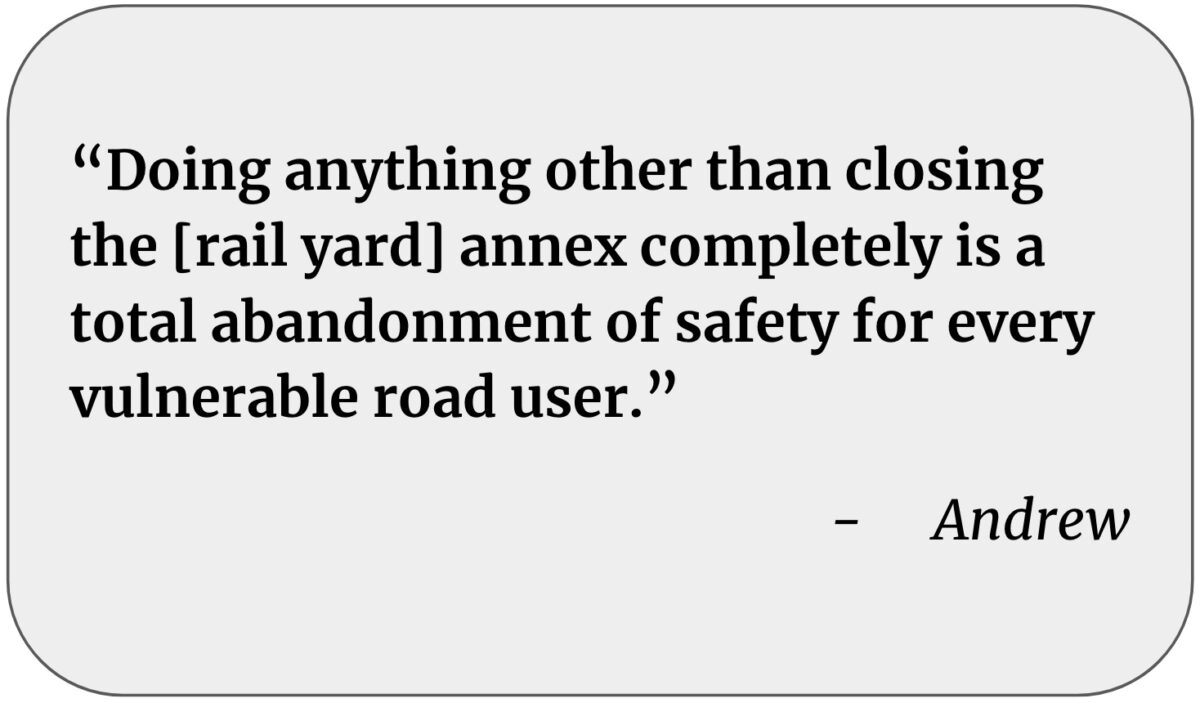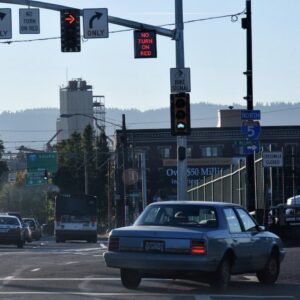Welcome to the Comment of the Week, where we highlight good comments in order to inspire more of them. You can help us choose our next one by replying with “comment of the week” to any comment you think deserves recognition. Please note: These selections are not endorsements.
Last week, the Portland Bureau of Transportation released plans to more appropriately route truck traffic accessing the Union Pacific Annex Yard, just east of the Brooklyn neighborhood. The rerouting comes in response to the deadly crash last month involving a semi-truck at 26th and Powell.
The comments in response to our story illustrate one of the strengths of the BikePortland comment section: knowledgeable readers commenting about what they know first-hand. I spent almost an hour with a satellite map following along.
Without wanting to detract from the seriousness of the problem, much of my interest came from the fact that I used to spend a fair amount of time in this neighborhood over a decade ago, but I haven’t visited it in a long time. So Andrew’s comment pulled me back into the area. Another commenter had me trying to figure out his route to the Winterhaven School. And entrance and egress to the rail yard consumed me for several minutes.
In another words, Andrew’s comment, and the thread of responses it initiated, were interesting.
Here is what Andrew wrote:
Insane that they don’t mention anything about how Gladstone between the Annex and 26th is a Safe Route to School and a city bikeway. The city doing anything other than closing the annex completely is a total abandonment of safety for every vulnerable road user. Elementary students from the Brooklyn Neighborhood use Gladstone to get to school at Grout, and it’s the only bikeway going southeast from Brooklyn as well.
The annex does not need to exist to fully serve the rail yard, they have full access to the entire regular freight transport network via Holgate and Harold entrances. They have plenty of other routes – and just elect not to take them due to how UP choses to run the yard operations. It’s insane to suggest that we just have to keep that area of the yard open – it doesn’t serve a single industrial client directly anymore and is only used to shortcut trucks onto Powell (via 26th and Gladstone).
Andrew’s comment can be found under the original post. Thank you Andrew and everyone else for commenting.






Thanks for reading.
BikePortland has served this community with independent community journalism since 2005. We rely on subscriptions from readers like you to survive. Your financial support is vital in keeping this valuable resource alive and well.
Please subscribe today to strengthen and expand our work.
Hear! Hear! This is good copy-pastable information to edit and make one’s own to send to PBOT and the rest of the City Council.
How does PBOT “close the annex”? At best they can ask UPRR to do so, which they did, and UPRR said no.
What are you proposing?
I too would like to know the answer to this. The city can’t just declare this use illegal. It’s allowed under the zoning code and even if that was changed, existing uses are always grandfathered as an allowed use.
I would propose that PBOT and the city ban freight traffic from the stretch of Gladstone/22nd between the Leigh cement lot and 24th. Which is basically banning freight trucks from using the annex (since it is not connected to the rest of the yard). And then aggressively enforce that ban, in court if necessary. Alternatively, just ban any multimodal trailer carrier from the “freight district area” bounded by 26th, the tracks, Holgate, and Powell – I have no issue with the other industrial uses in that area, since they generate a minimal proportion of the truck traffic compared to UPRR.
I don’t care if UPRR doesn’t like it – their choice to use it for trailer storage is literally killing people. It’s not some forgone conclusion that the kinds of freight movements involved with the annex should be allowed – especially since it requires the trucks to drive out of the yard and back in on streets that do not have a primarily freight designation (Gladstone, 26th, 22nd, etc.).
Also related – PBOT/PPB needs to aggressively enforce ticketing/fining of trucks who leave trailers parked on 22nd especially. Every time I go down there, I see them parked. UPRR using public right of way for storage needs to be stopped too.
There’s no way that would survive a court challenge.
It doesn’t really matter whether you care or not, it matters whether PBOT would make any headway in the inevitable lawsuit that would follow such an action. If it isn’t legal, frankly I don’t want PBOT doing it, both because I don’t want the city wasting its money fighting a doomed court battle, but also because it’s important that the government follow the law and proper process in everything it does, no matter how righteous the cause.
There is plenty of precedent for legal injunctions against railroads for safety/quality of life purposes. The Sellwood-Moreland and Eastmoreland neighborhoods had (maybe still have – the article I found about it was unclear on if it survived a more recent challenge by UPRR) something preventing Southern Pacific from building trains southbound a certain distance out of the Brooklyn yard at certain times of day. (https://www.oregonlive.com/portland/2011/04/union_pacific.html here is an article highlighting UPRR attempting to appeal that injunction)
Maybe my initial idea to ban all UPRR trucks from the area is not legally viable – but maybe a similar clause restricting truck movements to a certain time of day, or restricting the purpose of the annex to be storage of non-revenue items (empty trailers, etc.) would be. Or even something like paying UPRR to build an at-grade crossing for itself to connect the annex with the rest of the yard to eliminate the repetitive truck movements on smaller streets would be fine. Or buying the parcel of land from UPRR. Really pick whatever works best, as long as it stands some hope of getting done and changing the current status quo.
My larger point isn’t about a specific way to do it – it’s to highlight that PBOT does not really understand the issue here. The freight committee seems to think that all freight truck movements are fine and should be protected at all costs, but they are just flat out wrong there. UPRR is one of the largest corporations in the world, and they are abusing our city streets with a stupid gravel parking lot they won’t bother connecting to the rest of their rail yard – the freight committee appeasing them by appealing to “think of the smaller businesses that need freight access” is insane. Those businesses need freight access, but I find the entire tone of the freight committee to be contrary to the reality on the ground – Brooklyn is not some “gentrifying area” where housing uses are “crowding out” the historical industrial areas. It is a neighborhood where industry and housing have co-existed, and have been doing so since like 1890 or before.
PBOT should use any means necessary to protect people – fighting UPRR in court is absolutely worth all of our time and money. Because the alternative is them stomping all over public right of way and killing people. Doing nothing is simply unacceptable.
Had is right; it’s been gone for many years.
One solution did occur to me: PBOT could pay UPRR to close the exit. I don’t have any idea what it would take, but I am sure there is a number that would be acceptable to UPRR.
“Just flat out wrong”, “abusing our streets”, “stupid”, “insane”. These are not the words of analysis, but of morality and judgement. You claim that PBOT doesn’t understand the situation, but I think they do. They just don’t have many legal options (that I’m aware of) to close the exit, and even fewer options to enforce such a closure.
Court fights that are unwinnable are simply a pointless waste of resources. It might make sense for PBOT to find out what UPRR would accept to close the annex, they weigh that against the safety benefit such a closure would derive, which is not, as you suggest, infinite.
If the costs are lower than the benefit, move forward. If not, look for other areas where limited resources can be used to better reduce the potential for injury and death. In fact, even if the cost is lower than the benefit, it still might be better for PBOT to see if there are places they could spend the same money and save more lives.
Regarding PBOT and lawsuits, I know a tiny-weeny bit about this because of the legal arguments I helped to prepare for a land use appeal.
A city can proactively make some land-use cases more winnable, but it requires advice and cooperation of the City Attorney’s office.
One of the questions that PBOT asked in the Comparable Cities interviews section of the Streets 2035 Plan was about the strategy the cities used to gird themselves against Nolan/Dollan takings cases. Yes, some cities have put effort into this and are able to push back against developers/businesses that don’t want to make ordinance-required frontage improvements. But it takes having a strategy and implementing it consistently.
It seems like something similar could apply to the annex.
But I’m not aware (and I probably wouldn’t be) of PBOT/City pursuing anything like this. And my impression was that the city is very lawsuit averse.
It’s one thing to “take” some future potential development right by changing landuse law in general; it’s something quite different to “take” an active commercial use by targeting a single business that is doing nothing different than what any other business is doing.
Especially when that business is extremely well connected politically and has infinite money for lawyers.
Watts, neither one of us is an expert in this. I’m not talking about changing land use law. What UP has done differently is greatly increase the number and size of trains they run. That is a change that is placing people in danger.
I know — but that is what Nolan/Dollan is about if I recall correctly. Changing landuse law would be easier than what’s being discussed here because it doesn’t target a particular entity.
It’s true that larger trains is a change in their operations. We don’t know if that has resulted in more trucks using the Annex, but even if it has, PBOT isn’t closing the street access to other businesses that have had an increase in truck service.
We don’t even know if the truck involved in the most recent incident was coming from the Annex, was at fault, or even what happened. I think it would be hard to make the case that the private trucks servicing the UPRR are more dangerous than all the other trucks being driven around town (though they are more polluting, which is a different but important issue).
If PBOT finds a way to unilaterally cut off street access to part of the Brooklyn Yards, more power to them (maybe they have some ancient covenant making use of that entrance conditional in a dusty file cabinet right next to the Bike Plan and Transportation Hierarchy).
But I’m pretty confident it isn’t going to happen.
“UPRR using public right of way for storage needs to be stopped too.”
Uh… doesn’t that describe all on-street parking?
Eminent domain would be fine with me.
Eminent domain can only be used to take property and use it for a legitimate transportation purpose. You can’t just buy out any business you don’t like.
It’s not true it can only be used for transportation projects. But it’s also true it’s been abused by cities in the name of economic development, where land is taken (or attempted to be taken) from private owners and assembled for a larger, better-connected private owner.
I’d rather see the City buy the land than try to take it through eminent domain.
I ride from the Reed neighborhood to downtown through this area on my daily commute – and I honestly do not see a lot of traffic coming out of the Annex? Maybe it’s much heavier at 3PM when I’m not there – but this morning I didn’t encounter a single semi.